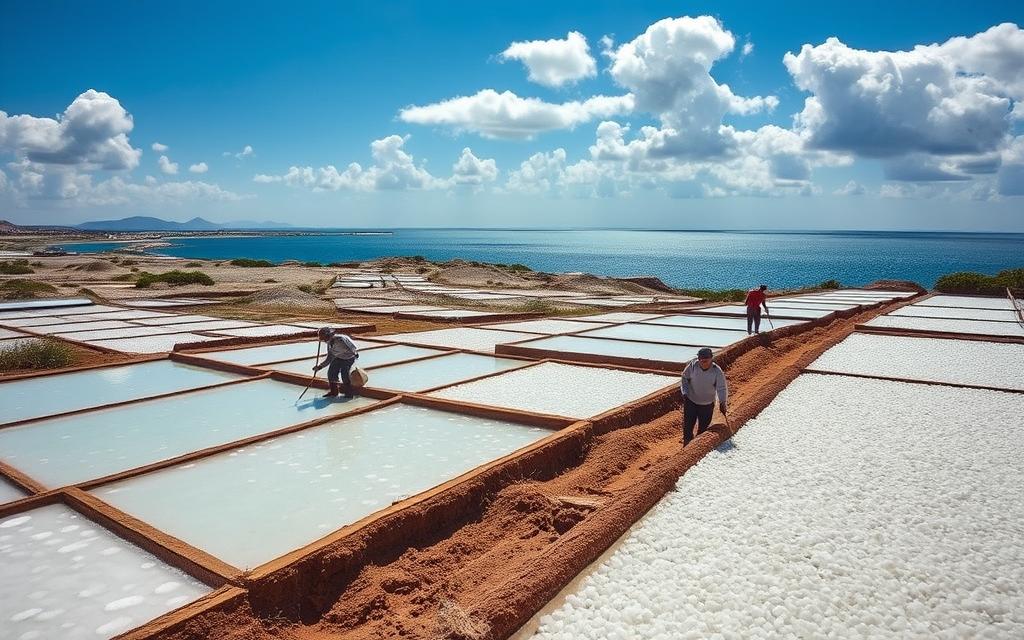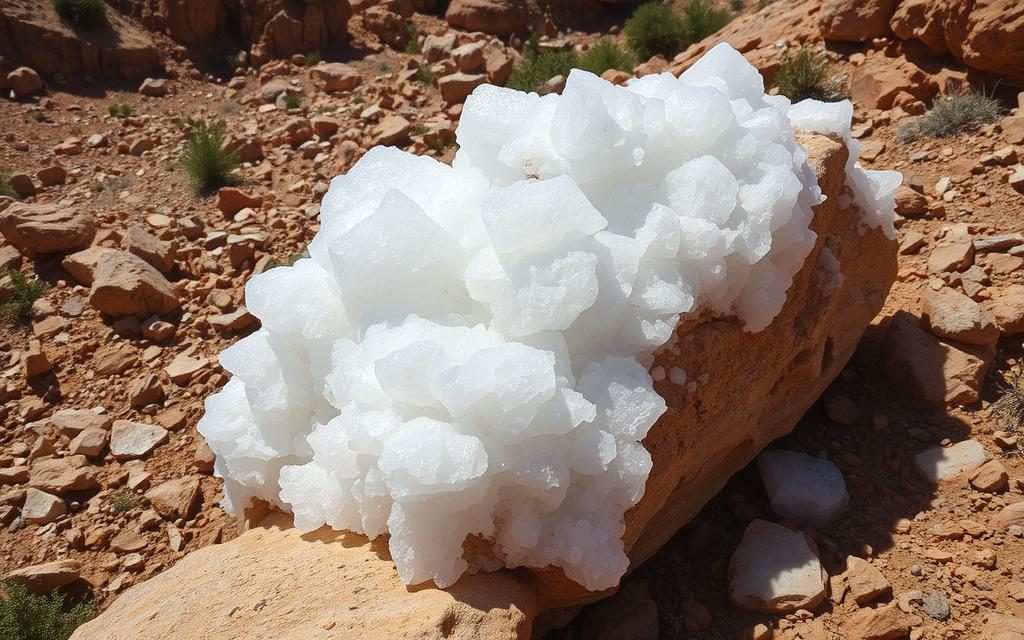
Ever wondered how something so small could shape entire civilizations? Salt, a mineral, has been key to human history. It comes from diverse sources around the world. From ancient trade routes to modern mining, salt’s journey shows human innovation and survival.
Salt sources are complex and interesting. Humans get salt from natural deposits, seawater, salt flats, and mines. The world produces three hundred million tonnes of salt every year. Each source has its own special ways of making salt.
Key Takeaways
- Salt production involves multiple complex methods across different geographical regions
- Natural salt deposits provide significant sources of mineral extraction
- Seawater contains approximately 2.6% salt, making it a critical production source
- China, the United States, India, and Germany lead global salt production
- Salt mining techniques vary from traditional evaporation to advanced underground extraction
Introduction to Salt
Salt is very important and has shaped our history, nutrition, and culture for thousands of years. It’s more than just a seasoning. It’s a key resource that has deeply influenced our development.
Salt is very important for our health. It gives us sodium and chlorine. These are important for our bodies to work right.
The Historical Significance of Salt
Salt’s history is full of human innovation and survival. Long ago, people knew salt was valuable. They used it for:
- Food preservation
- Trading currency
- Medical treatments
- Religious ceremonies
Salt’s Remarkable Uses Throughout History
Salt has been used in many ways, from cooking to industry. Salt making started at least 6000 BC in places like Romania and China.
| Historical Period | Salt Application |
|---|---|
| Ancient Times | Currency and Trade |
| Medieval Era | Food Preservation |
| Modern Era | Industrial and Medical Uses |
Salt’s journey through human history shows its key role in civilization’s growth.
Natural Salt Deposits
Salt is a fascinating mineral with a rich history. Rock salt, or halite, is one of the most interesting natural salt deposits. These formations tell us about ancient changes and geological processes.

Rock Salt: Formation and Characteristics
Halite forms when seawater or ancient lake beds evaporate. These salt deposits can be huge, up to 350 meters thick. The United States has big rock salt deposits in several areas:
- Appalachian basin
- Michigan basin
- Texas salt plains
- Ohio underground formations
- New Mexico geological zones
Geographic Distribution of Salt Mines
Salt mines are found in certain places. In the United States, major salt-producing states are:
- Kansas
- Louisiana
- Michigan
- New York
- Ohio
- Texas
- Utah
Detroit is on top of a huge salt deposit. Most road de-icing salt in the U.S. comes from an ancient seabed near Cleveland, 2,000 feet under Lake Erie.
Global Salt Production Insights
The world’s salt production is led by a few countries. China, the United States, India, Germany, Canada, and Australia are the top salt producers. The U.S. and China together produce 40% of the 250 million tons of salt made each year.
Sea Water
The world’s oceans are full of salt. They have an average salinity of 3.5%. This makes them a great place for making sea salt.
Every kilogram of seawater has about 35 grams of salt. This makes extracting salt from the ocean very interesting and important.
How Salt is Extracted from Ocean Water
There are two main ways to get salt from seawater. These are solar evaporation and artificial heating.
The solar evaporation method is used a lot in coastal areas. These areas have the right weather for it.
- Solar evaporation works best in areas with:
- High temperatures
- Low rainfall
- Abundant sunlight
- Shallow ponds capture seawater
- Sun gradually evaporates water
- Salt crystals remain behind
The Process of Evaporation
Evaporation is a natural process. Sunlight heats shallow ponds. This turns water into vapor, leaving salt crystals behind.
This method has been used for thousands of years. It’s also good for the environment.
Environmental Considerations
Today, making sea salt needs to be done in a way that’s good for the environment. We try to not hurt the ecosystem too much. We also use less energy when we heat the water artificially.
| Seawater Salt Composition | Percentage |
|---|---|
| Sodium | 30.6% |
| Chloride | 55% |
| Magnesium | 3.7% |
| Sulfate | 7.7% |
The ocean is a huge source of salt. If we dried up all the oceans, we’d get at least 4.5 million cubic miles of salt. This shows how much salt we can get from the ocean.
Salt Flats and Salinas
Salt flats are amazing geological wonders. They show us how salt is made and gathered. These places are white and important for our economy.
Understanding Salt Flats: A Geological Marvel
Salt flats are special places with lots of salt. They form in dry areas where water turns into salt. People have been getting salt from here for a long time.
World’s Most Impressive Salt Flats
- Salar de Uyuni (Bolivia): The world’s largest salt flat
- Salinas Grandes (Argentina): Covering approximately 50 square miles
- Atacama Salt Flat (Chile): Known for its extreme landscape
Economic Significance of Salinas
Salinas are very important for our economy. They help make salt for food and chemicals. In places like northern Argentina, salt making is a big job for people.
| Salt Flat Location | Size | Salt Production Capacity |
|---|---|---|
| Salar de Uyuni | 10,582 sq kilometers | 10 billion tonnes of salt |
| Salinas Grandes | 50 square miles | Salt layer ~1 foot deep |
The way salt is made in these places is very interesting. It shows how valuable salt is. Salt flats are a mix of nature’s beauty and economic value.
Underground Salt Mines
Salt mining is a cool process that finds important minerals deep in the Earth. Underground salt mines are key in making salt for the world. They use smart ways to get these minerals.

In the United States, there are amazing underground mines. They show off new mining ways. Salt beds can be up to 350 meters thick. Big salt deposits are found in places like:
- Appalachian basin in western New York
- Michigan basin
- Texas salt deposits
- Ohio underground salt beds
Notable Salt Mining Locations
The Detroit Salt Mine is a cool example of underground mining. It goes down over 1,100 feet. These mines use two main ways to mine:
- Room and Pillar Mining: Makes big rooms and keeps salt pillars for support
- Solution Mining: Uses water to dissolve salt and get brine
Safety Practices in Underground Mines
Salt mining cares a lot about keeping workers safe. They have good air systems, check the mine often, and make everyone wear safety gear.
| Mining Technique | Key Characteristics | Safety Considerations |
|---|---|---|
| Room and Pillar | Creates large underground chambers | Requires precise pillar design |
| Solution Mining | Dissolves salt using water injection | Monitors pressure and structural stability |
Today, salt mining gets better and better. It mixes old ways with new tech to get salt safely and well.
Salt from Salt Domes
Salt domes are cool geological formations. They are key in studying salt geology and finding natural resources. These structures rise up from underground, creating unique landscapes.

Creating salt domes takes a long time. It started about 190 million years ago in places like Louisiana. This made amazing salt patterns.
Geological Formation Characteristics
- Typically found in sedimentary basins
- Can reach heights of several thousand feet
- Formed through tectonic and geological pressure
- Frequently located in coastal regions
Notable Salt Dome Locations
| Region | Salt Dome Count | Geological Significance |
|---|---|---|
| Louisiana | 128 | Major petroleum industry resource |
| Zagros Mountains, Iran | 200+ | Salt glaciers extending up to 11 kilometers |
Extraction and Uses
Salt domes are mined using solution mining. Water is used to dissolve salt. Then, the brine is pumped out and processed.
The Gulf Coast in the United States is very important for salt domes. Many formations there are key for research and industry.
Salt Production from Brine Wells
Brine wells are a key way to get salt. They have been used for centuries. These underground places use new tech and know-how to get salt.
The brine production process is complex. It turns underground salt into something valuable. Salt extraction from brine wells starts with water being pushed into salt layers.
How Brine Wells Operate
Brine wells work in a special way:
- Water is pumped into underground salt deposits
- Salt dissolves, creating a concentrated brine solution
- The saturated brine is extracted to the surface
- Salt is separated through advanced evaporation techniques
The Extraction Process
The brine is very important in getting salt. Modern brine wells go very deep, over 1,000 meters. This method makes a lot of salt efficiently.
Using brine wells to get salt has big benefits:
- It doesn’t hurt the environment much
- It can make salt with the right amount of saltiness
- It can find specific salt deposits
- It doesn’t need as much hard work as mining
Places like China are leading in brine well tech. This shows how important it is for salt needs worldwide.
Salt from Mineral Sources
Mineral salts are a world of natural salts beyond table salt. They add flavor and trace minerals. This makes them special in cooking and health.
Exploring Different Types of Mineral Salts
Natural salt has many forms, each with its own traits. Some key mineral salts are:
- Himalayan Pink Salt: Mined in Pakistan, it has a pink color from minerals.
- Black Salt (Kala Namak): From India, it has a unique sulfur taste.
- Sea Salt: Made from seawater, it keeps minerals from the sea.
- Rock Salt: Found in underground rocks.
Benefits of Natural Mineral Salts
Mineral salts have more than sodium. They give us extra nutrients. Studies show they have minerals not in table salt.
| Salt Type | Sodium Content | Unique Characteristics |
|---|---|---|
| Himalayan Pink Salt | 40% sodium | Contains 84 trace minerals |
| Sea Salt | 40% sodium | Less processed, may contain ocean trace elements |
| Table Salt | 40% sodium | Most processed, often iodine-fortified |
Knowing about mineral salts helps us choose better. They taste great but we must watch our sodium.
Conclusion: The Future of Salt Sourcing
The global salt market is changing a lot. It was worth USD 14.61 Billion in 2023. It’s expected to grow to USD 20.02 Billion by 2032. Salt innovations are making big changes in the industry.
Companies like Cargill, Tata Chemicals, and Morton Salt are leading the way. They are making salt in a way that’s good for the planet and makes money.
Salt sourcing is getting better thanks to new technology. The global salt industry is using better ways to get salt. This includes chemical processing and industrial uses.
North America is a big player in the salt market. But, the Asia Pacific region is growing fast. It’s using new production methods and tapping into new markets.
Sustainable practices are key in salt harvesting. Big companies are working to be better for the environment. They are using better mining and extraction methods.
People around the world eat an average of 3.95 grams of salt each day. The industry needs to find a balance. It must meet nutritional needs, industrial demands, and protect the environment.
The salt market will see more innovation and care for the planet. Companies are investing in green technologies. This will help meet the growing demand for salt in different areas.
The future of salt sourcing looks exciting. It will be a mix of new technology and caring for the environment. This will shape the industry in new and important ways.




